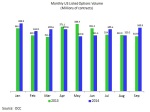In an effort to reign in a powerful campaign to launch secret sauce ETFs that have no business being used by ordinary investors, the SEC scored a smackdown on the creation of non-transparent ETFs in a recent ruling that blocks plans by ETF giant BlackRock as well as Precidian Investments to issue ETFs’ whose underlying constituents would otherwise be, well, non-transparent.
The topic of non-transparent ETFs has been a focus of several MarketsMuse articles in recent months. As reported last week by Bloomberg LP, The U.S. Securities and Exchange Commission rejected plans by BlackRock Inc. and Precidian Investments to open a new type of exchange-traded fund that wouldn’t disclose holdings daily, setting back efforts to bring more actively managed ETFs to market.
The SEC, in preliminary decisions announced yesterday, denied BlackRock’s September 2011 and Precidian’s January 2013 requests for exemptive relief from the Investment Company Act of 1940. The move puts on hold plans by the firms to start the first non-transparent ETFs.
The Precidian proposal falls “far short of providing a suitable alternative to the arbitrage activity in ETF shares that is crucial to helping keep the market price of current ETF shares at or close” to its net asset value, Kevin O’Neill, a deputy secretary at the SEC, wrote in the letter.
The ruling hinders plans by asset managers to sell funds run by traditional stock-picking managers in an ETF package. Firms including Capital Group Cos. have asked for similar regulatory approval as they seek to expand offerings in the fastest-growing product in the asset-management industry.
Money managers have been discouraged from introducing active ETFs, which combine security selection with the intraday trading and some of the cost-saving features of traditional ETFs, because the SEC’s requirement for daily disclosure of holdings would make it easy for competitors to copy, and traders to anticipate, a manager’s portfolio changes.
‘Not Surprised’
“We want to work with the SEC — we believe it’s part of the process,” Daniel McCabe, Precidian’s chief executive officer, said in a telephone interview. “We’re not surprised by the fact that they have questions, but questions can be answered.”
ETF providers must disclose holdings every day to enable market makers to execute trades that keep the share price in line with the underlying value of the fund’s assets. Firms including BlackRock, Precidian and Guggenheim Partners LLC proposed structures that they say would allow the funds to remain priced in line with assets, without revealing specific positions.
T. Rowe Price Group Inc. in Baltimore and Boston’s Eaton Vance Corp. are also among fund firms seeking SEC approval for non-transparent active ETFs. None of the applications has been approved.
“We are still pursuing our own proposal to offer non-transparent active ETFs,” Heather McDonold, a spokeswoman for T. Rowe, said in a telephone interview.
Commercial Opportunity
Melissa Garville, a spokeswoman for New York-based BlackRock, and Ivy McLemore, a spokesman for Guggenheim, declined to comment. Robyn Tice, a spokeswoman for Eaton Vance, and Elizabeth Bartlett for State Street Corp. didn’t immediately respond to an e-mail and telephone messages seeking comment.
BlackRock was one of the first U.S. fund managers to ask the SEC for approval, after spending three years crafting the product. Their leading role in seeking approval for a non-transparent active ETF has spurred excitement within asset management for the product’s prospects, according to Todd Rosenbluth, director of mutual-fund and ETF research at S&P Capital IQ in New York.
Mark Wiedman, BlackRock’s global head of its iShares ETF unit, said in May that the firm was confident the products would work, “but we don’t actually think it will be much of a commercial opportunity.”
For the full story from Bloomberg reporter Mary Childs, please click here
![]() Trading in equities options is enjoying a resurgence, thanks to recent volatility in underlying cash markets, a burst in IPO activity and heightened hedging action in the stocks of companies such as Apple, Inc. according to reporting by TradersMag. Citing a TABB Group recent study, 0ptions mart trading volume exceeded 1 billion contracts in Q3. The third quarter gains represent a 4.9% increase from the second quarter total and an 8.2% increase from the year-earlier period.
Trading in equities options is enjoying a resurgence, thanks to recent volatility in underlying cash markets, a burst in IPO activity and heightened hedging action in the stocks of companies such as Apple, Inc. according to reporting by TradersMag. Citing a TABB Group recent study, 0ptions mart trading volume exceeded 1 billion contracts in Q3. The third quarter gains represent a 4.9% increase from the second quarter total and an 8.2% increase from the year-earlier period. In its latest research, “U.S. Options Market Review: Third Quarter 2014,” Tabb Group also reported that U.S. options volume rebound was driven in part by a 15.8% jump in September’s total as retail fervor around Apple’s new product announcements, the Alibaba IPO and rising volatility brought monthly volume to 365.9 million contracts.
In its latest research, “U.S. Options Market Review: Third Quarter 2014,” Tabb Group also reported that U.S. options volume rebound was driven in part by a 15.8% jump in September’s total as retail fervor around Apple’s new product announcements, the Alibaba IPO and rising volatility brought monthly volume to 365.9 million contracts.








